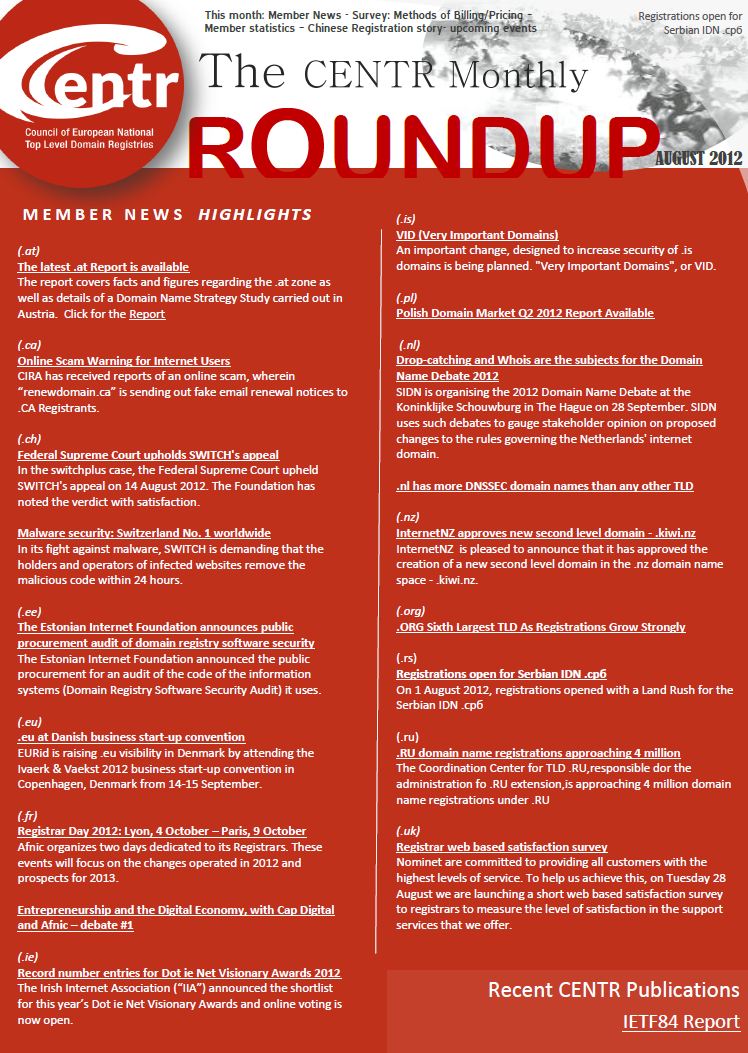News

Monthly Roundup August 2012
The latest edition of the CENTR Roundup newsletter is now available covering activities from August 2012.
This edition includes;
- Member news highlights
- Survey summary: Pricing and Billing Methods
- CENTR Statistics
- Article: A short overview of Chinese Registrations
- Upcoming CENTR Events

Click to download the roundup
_________________________________________________________
Monthly Roundup Archive

Federal Supreme Court upholds SWITCH's appeal
In the switchplus case, the Federal Supreme Court upheld SWITCH's appeal on 14 August 2012. The Foundation has noted the verdict with satisfaction.
On 22 March 2012, SWITCH lodged an appeal with the Federal Supreme Court against the verdict of the Federal Administrative Court of 13 February 2012. This verdict banned SWITCH from providing a link to its subsidiary switchplus ag on the www.switch.ch website. SWITCH's appeal was upheld in its entirety by the Federal Supreme Court on 14 August 2012.
SWITCH acted correctly
"With its decision, the Federal Supreme Court is supporting SWITCH's economic freedom", explains Andreas Dudler, Managing Director of SWITCH. The decision specifies inter alia that it must be possible for SWITCH to provide information on the group website www.switch.ch not only about its core business for the universities but also on the services of its subsidiary switchplus. With its verdict, the Federal Supreme Court also confirms that SWITCH has not given its subsidiary switchplus an unlawful advantage.
Background
In response to the sustained calls from domain name customers for hosting services, SWITCH set up its commercial subsidiary switchplus ag in 2009. This provides services associated with an internet presence – from the registration of the domain name, via web mail and CMS hosting, right through to hosted exchange. SWITCH uses its subsidiary's profits to support Switzerland's universities.
End of the legal dispute
After switchplus ag had been set up, a group of hosting providers prevented the market entry of the subsidiary. The decision taken by the Federal Supreme Court should now have put an end to this longstanding discussion. "We welcome this pioneering decision by the Federal Supreme Court. It confirms that SWITCH has always acted correctly", says Marco D'Alessandro, media spokesman for SWITCH.
Go to Article

Icelandic Registry introduce VID (Very Important Domains)
ISNIC is always evolving the registration of .is domains. A very important change, which is designed to increase the security of .is domains further, is being planned. This includes being able to mark domains as "very important domains", or VID.
VID's will get special treatment, especially regarding rights and renewals. So called VID insurance means that a VID's registration never expires accidentally. It will also be harder to transfer VID's to new registrants, since it will require confirmation from the registrants themselves, either digitally or a signed confirmation.
To prepare for this change, domain registrants are asked to update the registrants email at ISNIC, which can be done under "Modify Registration" on My Page. Only the administrative contact can edit the registrant information. In the fall, all administrative contacts and registrants with a registered email address will get an email where these changes will be explained in detail.

Drop-catching and Whois at Domain Name Debate 2012
SIDN is organising the 2012 Domain Name Debate at the Koninklijke Schouwburg in The Hague on 28 September. SIDN uses such debates to gauge stakeholder opinion on proposed changes to the rules governing the Netherlands' internet domain. At the debates, any interested party can have a say and thus help to shape future policy. The fourth Domain Name Debate focuses on drop-catching and further restriction of the amount of information about private registrants available from the Whois.
...Read More (Full Article)

InternetNZ approves new second level domain - .kiwi.nz
- represents an identifiable, significant community of interest.
- represents an on-going and long-lived community of interest.
- does not conflict with, duplicate or cause confusion about, any existing second-level domain and is a useful addition to the current DNS (Doman Name System) hierarchy.
- uses a name to represent the domain that is an obvious derivative of a word that properly describes the community of interest, e.g. .org.nz for organisation, or a complete word, e.g. .maori.nz.
- does not bring the .nz domain name space into disrepute.
Go to Original Article

Results of the nic.at Domain Strategy Study 2012
Within the latest NIC.at Domain Name Report are results of a study carried out on Domain Strategy (including details on impacts of new gTLDs)
Click for the Report

Record number of entries for Dot ie Net Visionary Awards 2012
The Irish Internet Association (“IIA”) today announces the shortlist for this year’s Dot ie Net Visionary Awards and online voting is now open. It’s the start of award season and the fully refreshed IIA awards are the first off. With huge thanks to our headline sponsor in IE Domain Registry Limited (“IEDR”), new categories, a stunning venue at the National Gallery of Ireland and a record number of entries, up 30% on last year, these awards are the ones to watch.
The IIA have been setting the agenda all year – eCommerce strategy, BRIC export market opportunities, cloud standards, development for accessibility and much more. We’ve reflected these issues in the new categories; Best International “we’ll conquer the world” Irish Technology Business, The Bravest and Best “brick to click” Business, Most “joyous to look and splendid to use” Web Design, Most Indispensible Cloud Service for SMEs. These awards are more than just trophies, they are coveted titles.
Go to Full Article

The Estonian Internet Foundation announces the public procurement for an audit of domain registry software security
The Estonian Internet Foundation announces the public procurement for an audit of the code of the information systems (Domain Registry Software Security Audit) it uses. This public procurement has been entered in the Registry of Public Procurements under number 132095. The bid submission deadline is 10 September 2012.
The Estonian Internet Foundation is commissioning a Domain Registry Software Security Audit, the results of which must contain answers to the following questions: 1) code security; 2) code quality; 3) quality of information system data administration; 4) suitability of the information system for DNSSEC implementation; and 5) information system sustainability.
The public procurement documents, contract and participation terms and conditions are available under the corresponding number in the Registry of Public Procurements. This public procurement has been entered in the Registry of Public Procurements under number 132095. The bid submission deadline is 10 September 2012.
You can apply and view the public procurement documentation by no later than 12:00 on 6 September 2012.
Please download the public procurement documentation form and submit your questions through the Registry of Public Procurements.

Polish Domain Name Market - Q2 2012 Report Available
Click to access the Q2 Report from NASK concerning the Polish Domain Name Market

Add-on for Internet Explorer Protects Users from Fraudulent Websites
Prague, 25 July 2012 – CZ.NIC Laboratories, the research department of the maintainer of the .CZ national domain, in cooperation with the Czech representative of Microsoft, have launched the DNSSEC Validator, a new security add-on for Internet Explorer (IE) browsers. With this application, the browser can verify whether the visited websites are secured by DNSSEC technology. This way, users can know immediately that the site is not fraudulent and that there is, for example, no risk of sensitive data theft.
“According to a study of the NSS Labs security company, Internet Explorer versions 8 and above consistently rank first in efficacy in the fight against Internet attacks, particularly thanks to IE security features such as the SmartScreen Filter or the Application Reputation system. DNSSEC Validator is another element that further strengthens the security of Internet Explorer users, protecting them from fraudulent websites which are appearing increasingly often in the Czech Republic,” says Lukáš Křovák, manager of the Windows Client division at Microsoft.
CZ.NIC Laboratories has already published several versions of the DNSSEC Validator plugin for Mozilla Firefox and Google Chrome browsers. Now the add-on has been released for Internet Explorer as well, so far only for 32-bit versions (IE versions 6 through 9). More information on the current version 1.0 is available on the project website - http://www.dnssec-validator.cz/ie/.
ABOUT THE DNSSEC TECHNOLOGY
DNSSEC is the extension of the DNS system, which increases the security of domain names. The principle of DNS is the translation of human-friendly Internet addresses, such as www.nic.cz or www.dobradomena.cz, into numerical addresses understood by computers, which can in turn provide services such as displaying web pages, sending e-mails, Internet telephony etc. DNSSEC increases security while using DNS by preventing forged, altered or incomplete domain name data. CZ.NIC association, as the administrator of the .CZ and ENUM domain registries, implemented this security technology for the holders of these domains and for the users of the Czech Internet in September 2008. More information can be found at www.nic.cz/dnssec/.
Full Article
